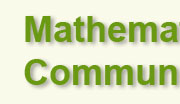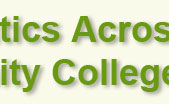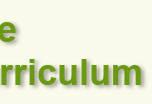- Alibert, Daniel. "Towards New Customs in the Classroom." For the Learning of Mathematics. 8 (1988): 31-43.
- American Mathematical Association of Two-Year Colleges. Crossroads in Mathematics: Standards for Introductory College Mathematics Before Calculus. Memphis, TN.: AMATYC, 1995.
- Angelo, Tom and Pat Cross. Classroom Assessment Techniques: A Handbook for Faculty. 2nd ed. San Francisco: Jossey, 1993.
- Arem, Cynthia. Conquering Math Anxiety: A Self-Help Workbook. Belmont, CA.: Wadsworth, 1993.
- Ascher, Marcia. Ethnomathematics: A Multicultural View of Mathematical Ideas. Pacific Grove, CA.: Brooks/Cole, 1994.
- Ascher, Marcia and Ascher, Robert. Mathematics of the Incas: Code of the Quipu. Mineola, New York: Dover Publications, 1997.
- Brophy, J. and Good, T. Teacher-Student Relationship: Causes and Consequences. New York: Holt, 1970.
- Brufee, K. Collaborative Learning: Higher Education, Interdependence, and the Authority of Knowledge. Baltimore: Johns Hopkins UP, 1993.
- Bunt, Lucas N.H. The Historical Roots of Elementary Mathematics. New York: Dover Publications, 1988.
- Burns, Marilyn. Math: Facing an American Phobia. Sausalito, CA.: Math Solutions, 1998.
- Cheney, Lynn V. 50 Hours: A Core Curriculum for College Students. Washington, DC: National Endowment for the Humanities, 1989.
- Closs, Michael P. ed. Native American Mathematics. Austin, TX: University of Texas Press, 1986.
- Connolly, Paul, and Teresa Vilardi, eds., Writing to Learn Mathematics and Sciences. New York: Teachers College Press, Columbia University, 1989.
- Devlin, Keith. The Math Gene. How Mathematical Thinking Evolved and Why Numbers are Like Gossip. New York: Basic Books, 2000
- Dodd, Anne Wescott. "Insights from a Math Phobic." The Mathematics Teacher 85:4 (1992): 296-298.
- Dubinsky, E., D. Matthews, and B. Reynolds, eds. Readings in Cooperative Learning for Undergraduate Mathematics. MAA Notes 44. Washington, D.C.: Mathematical Association of America, 1997.
- Egan, Kieran. The Educated Mind: How Cognitive Tools Shape Our Understanding. Chicago: U of Chicago P, 1997.
- Eglash, Ron. African Fractals: Modern Computing and Indigenous Design. New Brunswick, N.J.: Rutgers University Press, 1999.
- Gabelnick, F., J. MacGregor, R. Mathews, and B.L. Smith. Learning Communities: Creating Connections among Students, Faculty and Disciplines. New Directions for Teaching and Learning 41. San Francisco: Jossey, 1990.
- Ganguli, Aparna."Integrating Writing in Developmental Mathematics College Teaching." College Teaching 37 (1989): 140-142.
- Garland, Trudi Hammel. Fascinating Fibonaccis. Mystery and Magic in Numbers. Palo Alto, CA: Dale Seymour, 1987.
- Garland, Trudi Hammel and Kahn, Charity Vaughan. Math and Music: Harmonious Connections. Palo Alto, CA: Dale Seymour, 1995.
- Gerdes, Paulus. Women, Art, and Geometry in Southern Africa. Trenton, NJ: Africa World Press, 1998.
- ---. Geometry from Africa : mathematical and educational explorations. Washington, DC: Mathematical Association of America, c1999.
- Hativa, Nira. "What makes Mathematics Lessons Easy to Follow, Understand, and Remember?" College Mathematics Journal 14 (1983): 398-406.
- Hale-Benson, Janice E. Black Children: Their Roots, Culture and Learning Styles. Baltimore: The Johns Hopkins UP, 1982.
- Howard, Gary R. We Can't Teach What We Don't Know: White Teachers, Multiracial Schools. New York: Teachers College Press, Columbia University, 1999.
- Huff, Darrell. How to Lie With Statistics. New York, NY: W.W. Norton & Co., 1982.
- Hyde, J. S., E. Fennema., M. Ryan, L. Frost, and C. Hoop. "Gender Comparisons of Mathematics Attitudes and Affect: A Meta-Analysis." Psychology of Women Quarterly 14 (1990): 299-324.
- Jones, Burton. "The Moore Method." American Mathematical Monthly 84 (1977): 273-278.
- Joseph, George Gheverghese. The Crest of the Peacock. London: Penguin Books, 2000.
- Katz, Victor, ed. Using History to Teach Mathematics; An International Perspective.Washington, DC: MAA, 2000.
- Kogelman, Stanley, and Joseph Warren. Mind Over Math. New York: McGraw, 1979.
- Krause, Marina C. Multicultural Mathematics Materials. Reston, VA: National Council of Teachers of Mathematics, 1983.
- Lakoff, George and Nunez, Rafael E. Where Mathematics Comes From. How the Embodied Mind Brings Mathematics into Being. New York, NY: Basic Books, 2000.
- Lave, Jean. Cognition in Practice: Mind, Mathematics and Culture in Everyday Life. Cambridge: Cambridge UP. 1988.
- Leitzel, James R.C., ed. A Call for Change: Recommendations for the Mathematical Preparation of Teachers of Mathematics. Washington, DC: Mathematical Association of America, 1991.
- Linn M. and C. Kessel. "Success in Mathematics: Increasing Talent and Gender Diversity." Research in Collegiate Mathematics Education II. Ed. A. Schoenfeld, E. Dubinsky, and J. Kaput Providence, RI: American Mathematical Society, 1996. 101-144.
- Loacher, Georgine, ed. Self Assessment at Alverno College. Milwaukee, WI: Alverno College Institute, 2000.
- Lumpkin, Beatrice. Geometry Activities from Many Cultures. Portland, ME: J. Weston Walch, 1997.
- MacGregor, Jean, compiler. Strengthening Learning Communities: Case Studies from the National Learning Communities Dissemination Project (FIPSE). Olympia, WA: The Evergreen State College, Washington Center for Improving the Quality of Undergraduate Education, 1999.
- Mankiewicz, Richard. The Story of Mathematics. Princeton, NJ: Princeton University Press, 2001.
- Martin, Hope and Long, Madeleine J. Integrating Mathematics across the Curriculum, Vol. 1. Arlington Heights, IL: SkyLight Professional Development, 1996.
- McLeod, Douglas, and Michele Ortega. "Affective Issues in Math Education." Wilson. 21 38.
- McLeish, John. The Story of Numbers: How Mathematics Has Shaped Civilization. New York: Fawcett Books, 1994.
- McLone, R.R. "On the Relationship between Curriculum, Teaching, and Assessment of Mathematics." International Journal of Mathematics Education, Science and Technology 2 (1971): 341-344.
- Meier, John and Thomas Rishel. Writing in the Teaching and Learning of Mathematics. Washington, D.C.: The Mathematical Association of America, 1998.
- Moses, Robert P. and Charles E. Cobb, Jr. Radical Equations: Organizing Math Literacy in America's Schools. Boston, MA: Beacon Press, 2001.
- NCTM, Professional Standards for Teaching Mathematics. Reston, VA: NCTM, 1991.
- NRC. Everybody Counts: A Report to the Nation on the Future of Mathematics Education. Washington, DC: National Academy Press, 1989.
- ---. Moving Beyond Myths: Revitalizing Undergraduate Mathematics. Washington, DC: National Academy Press, 1991.
- Nelson, David, George Gheverghese Joseph, and Julian Williams. Multicultural Mathematics: Teaching Mathematics from a Global Perspective. New York: Oxford UP. 1993.
- Paulos, John Allen. Beyond Numeracy: Ruminations of a Numbers Man. New York: Vintage, 1992.
- ---. Innumeracy: Mathematical Illiteracy and its Consequences. New York: Vintage, 1988.
- ---. A Mathematician Reads the Newspaper. New York: Anchor, 1996.
- ---. Once Upon A Number: The Hidden Mathematical Logic of Stories. New York: Basic, 1998.
- Powell, Arthur B. and Marilyn Frankenstein, eds. Ethnomathematics: Challenging Eurocentrism in Mathematics Education. Albany, NY: State U of New York P, 1997.
- Reynolds, B. N., K. Hagelgans, D. Schwingendorf, E. Vidakovic, E. Dubinsky, M. Shahin, and G. Wimbish. A Practical Guide to Cooperative Learning in Collegiate Mathematics. Washington, DC: Mathematical Association of America, 1995.
- Ritchhart, Ron. Making Numbers Make Sense. A Sourcebook for Developing Numeracy. Menlo Park, CA: Addison-Wesley, 1994.
- Schoenfeld, Alan H.,ed. A Source Book for College Mathematics Teaching: A Report from the MAA Committee on the Teaching of Undergraduate Mathematics. Washington, DC: Mathematical Association of America, 1990.
- Slavin R. "Synthesis of Research on Cooperative Learning." Educational Leadership, 60, (1991).
- Steen, Lynn Arthur and Steen, Lyn A., eds. Why Numbers Count: Quantitative Literacy for Tomorrow's America. New York, NY: CEEB, 1997.
- Steen, Lynn Arthur, ed. Mathematics and Democracy. The Case for Quantitative Literacy. Princeton, NJ: NCED, 2001.
- **See the bibliography on pages 117-121 for a list of more resources related to quantitative literacy**
- Sterrett, Andrew. Using Writing to Teach Mathematics. MAA Notes 16. Washington, DC: Mathematical Association of America, 1990.
- Stewart, Ian. Nature's Numbers: The Unreal Reality of Mathematics. New York, NY: Basic Books, 1995.
- Tahan, Malba. The Man Who Counted: A Collection of Mathematical Adventures. New York, NY: W.W. Norton & Company, 1993.
- Tall, David. "The Transition to Advanced Mathematical Thinking: Functions, Limits, Infinity, and Proof." Handbook of Research in Mathematics Teaching and Learning. Ed. D. Grouws, Reston, VA: National Council of Teachers of Mathematics, 1992.
- Tobias, Sheila. Overcoming Math Anxiety. New York: Norton, 1993.
- ---. Succeed with Math. Every Student's Guide to Conquering Math Anxiety. New York: Macmillan, 1987.
- ---. They're Not Dumb, They're Different: Stalking the Second Tier. Tucson, AZ: Research Corporation, 1990.
- Tobias, Sheila and Jacqueline Raphael. The Hidden Curriculum: Faculty-Made Tests in Science. Part 1: Lower-Division Courses. New York: Plenum, 1997.
- Tobias, S. and C. Weissbroad. "Anxiety and Math: An Update." Harvard Educational Review 50 (1980): 63-70.
- Treisman, Philip Uri. "A Study of the Mathematics Performance of Black Students at the University of California, Berkeley." Mathematicians and Education Reform: Proceedings of the 1988 Workshop. CBMS Series on Issues in Mathematics Education, Volume 1. Providence, RI: American Mathematical Society, 1988. 34-46.
- Tufte, Edward R. Envisioning Information Cheshire, CT: Graphics, 1990.
- ---. The Visual Display of Quantitative Information. Cheshire, CT: Graphics, 1983.
- ---. Visual Explanations:Images and Quantities, Evidence and Narrative. Cheshire, CT: Graphics, 1997.
- Webb, Norman L., ed. Assessment in the Mathematics Classroom (1993 Yearbook). Reston, VA: NCTM, 1993.
- Wilson, Patricia, ed. Research Ideas in the Classroom: High School Mathematics. New York: Macmillan, 1993.
- Wolfe, Christopher R. "Quantitative Reasoning Across a College Curriculum." College Teaching 41:1 (Winter 1993): 3-9.
- Zaslavsky, Claudia. Multicultural Mathematics:Interdisciplinary Cooperative-Learning Activities. Portland, Maine: J. Weston Walch, 1999.
- ---. Africa Counts:Number and Pattern in African Culture. Westport, Conn.: Lawrence Hill & Co., 1979.
- ---.The Multicultural Math Classroom: Bringing in the World. Portsmouth, NH: Heinemann, 1995.
-
What Did Jane Find?
Deann Leoni, 2008, Edmonds Community College (pdf 270kb)
MAC3 Evaluation Process offers 3 measurement points: Institute experience, Faculty implementation, Student results.
-
The Impact of the Mathematics Across the Community College (MAC3) Project on Students’ Learning and Attitudes about Mathematics
Deann Leoni, 2008, Edmonds Community College (pdf 5MB)
MAC3 supports faculty of all disciplines in creating curriculum that enhances the mathematical or quantitative literacy dimensions in their courses. As a result, community college students throughout the nation will be offered opportunities to deepen and reinforce the mathematics they have learned in their math classes, apply it in context, and understand its greater importance and application in their lives.
-
Reading Your Way to Success in Math
Honey Kirk, 2008 (pdf 90kb)
-
Math: The Eligible Bachelor! Marrying Math with other classes in a Successful Learning Community
Beverly Vredevelt, WYMATYC Conference, February 8 – 9, 2008, Spokane Falls Community College (pdf 750kb)
-
Mathematics Across the Curriculum – a Strategy for Quantitative Literacy
Deann Leoni & Beverly Vredevelt, 2008, Edmonds Community College & Spokane Falls Community College (pdf 10MB)
-
A Quantitatively Literate Student Should Be Able To. . .
Deann Leoni, April 2008, Edmonds Community College (pdf 15MB)
-
The 3 R’s: Do They Work Together? Math and English Learning Communities
Beverly Vredevelt, WYMATYC, February 2008, Spokane Falls Community College (pdf 1MB)
-
What? Why? When?,Workshop for ACCCESS Fellows
Rebecca Hartzler, November 3, 2007, Seattle Central Community College (pdf 9MB)
What is QL and MAC? Why would you want to be involved? What work and opportunities are available.
|









